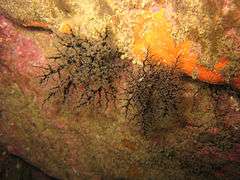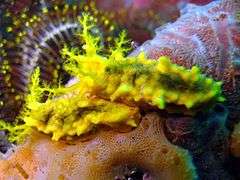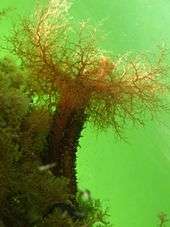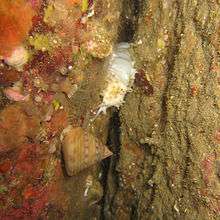Cucumariidae
Cucumariidae is a family of sea cucumbers, marine animals with elongated bodies, leathery skins and tentacles that are found on the sea bed.
| Cucumariidae | |
|---|---|
 | |
| Pseudocolochirus violaceus | |
| Scientific classification | |
| Kingdom: | |
| Phylum: | |
| Class: | |
| Subclass: | |
| Order: | |
| Family: | Cucumariidae Ludwig, 1894 [1] |
| Genera | |
|
| |
Taxonomy
A number of species that were placed in the family Phyllophoridae by Thander in 1989 and 1990 are now included in Cucumariidae.[1]
Biology
Members of the family Cucumariidae are small to medium-sized sea cucumbers, characterised by ten branching tentacles of which the lowest two are often smaller than the others. They are filter feeders, using their tentacles to catch micro-organisms and pass them to their mouth. They are seldom found on coral reefs but mostly live in deep water on sand and gravel substrates.[2]
Certain genera including the sea apples in the genera Paracucumaria and Pseudocolochirus, contain toxic holothurin and holotoxin and release it into the water when damaged or killed. Spawning may also be accompanied by release of these toxins. For this reason, although they are interesting and attractive to keep in aquaria, it is inadvisable to keep them in a tank with other reef species.[3]
Genera
The generally accepted genera include:
- Abyssocucumis Heding, 1942
- Actinia Pallas, 1766
- Actinocucumis Ludwig, 1875
- Amphicyclus Bell, 1884
- Anaperus Troschel, 1846
- Apseudocnus
- Apsolidium O'Loughlin & O' Hara, 1992
- Aslia Rowe, 1970
- Australocnus
- Benthophyllophorus
- Botryodactyla
- Caespitugo Gutt, 1990
- Cercodemas Selenka, 1867
- Cladodactyla Brandt, 1835
- Colochirus Troschel, 1846
- Cucamba
- Cucumaria Blainville, 1830
- Cucumella Heding, 1935
- Cucuvitrum O'Loughlin & O' Hara, 1992
- Ekmania Hansen & McKenzie, 1991
- Eucyclus
- Euthyonacta
- Euthyonidium
- Hemioedema Hérouard, 1929
- Heterocucumis Panning, 1949
- Labidodesmus
- Leptopentacta H.L. Clark, 1938
- Loisettea Rowe & Pawson, 1985
- Mensamaria H.L. Clark, 1946
- Microchoerus Gutt, 1990
- Neoamphicyclus Hickman, 1962
- Neocnus Cherbonnier, 1972
- Neocucumella Pawson, 1962
- Neocucumis Deichmann, 1944
- Ocnus Forbes & Goodsir, in Forbes, 1841
- Orbithyone Clark, 1938
- Orcula
- Panningia Cherbonnier, 1958
- Paracolochirus
- Paracucumaria Panning, 1949
- Parathyonacta
- Parathyone
- Parathyonidium
- Parocnus
- Patallus Selenka, 1868
- Pawsonellus Thandar, 1986
- Pawsonia Rowe, 1970
- Pentacta Goldfuss, 1820
- Pentactella
- Pentocnus O'Loughlin & O'Hara, 1992
- Plesiocolchirus Cherbonnier, 1946
- Plesiocolochirus Cherbonnier, 1946
- Pseudaslia Thandar, 1991
- Pseudoaslia Thandar, 1991
- Pseudocnella Thandar, 1987
- Pseudocnus Panning, 1949
- Pseudocolochirus Pearson, 1910
- Pseudopsolus Ludwig, 1898
- Pseudrotasfer
- Psolidiella Mortensen, 1926
- Psolidocnus
- Psoliocucumis
- Roweia Thandar, 1985
- Semperia
- Siphothuria
- Squamocnus O'Loughlin & O'Hara, 1992
- Staurocucumis Ekman, 1927
- Staurothyone H.L. Clark, 1938
- Stereoderma Ayres, 1851
- Thyonacta
- Thyonella Verrill, 1872
- Thyonidium Düben & Koren, 1846
- Trachasina Thandar
- Trachycucumis
- Trachythyone Studer, 1876
- Uroxia Costa, 1869 [1]
 Aslia lefevrii
Aslia lefevrii

.jpg)
